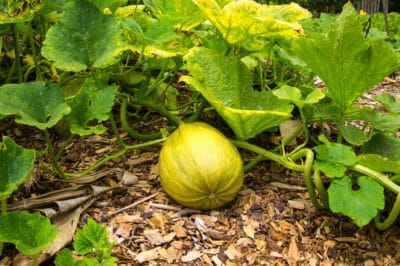The Stress of Insufficient Water
Insufficient water to the roots of a squash plant can result in leaves turning yellow. Squash plants require about 2 inches of water per week. During the fruiting stage of growth, the plant may require more water, especially in hot, dry weather. To encourage deeper roots, water squash plants less often but more deeply.
The Stress of Iron Deficiency
An iron deficiency (chlorosis) should be suspected if the leaf veins of the squash plants are green but area between the veins is yellow. A lack of iron availability, not deficiency, is a more accurate description of the problem. Here are natural methods of correcting the availability of iron in soil:
- Lower soil pH.
- Correct clay soil by adding organic matter.
- Improve compacted soil.
- Correct overly wet soil.
- Reduce phosporus in soil.
The Stress of Bacterial Wilt
Erwinia tracheiphila, a bacterium, is a cause for loss of cucurbit plants including squash. The first clue that your plant may have bacterial wilt is leaves turning dull green, wilting in the day, and recovering from wilting at night. Leaves will then begin to turn yellow, wither, and die. Unfortunately, this process continues, killing the entire plant.
Bacterial Wilt is spread by the spotted and striped cucumber beetles. Some of the beetles contract the bacteria from eating infected plants. The bacteria overwinter in the guts of beetles. The bacteria is spread by the infected beetles’ mouthparts and their fecal matter. Controlling the beetles is the only effective way to prevent bacterial wilt.
The Stress of Squash Vine Borers
The flow of vital nutrients and water is halted by the damage of the piercing-sucking mouthparts of the squash vine borer. Efforts should be made to eliminate the borer from the squash plants as soon as possible.
The first line of defense is preventing the adult borer from laying its eggs. If eggs are laid, they can be removed. Sometimes the borer succeeds with laying the eggs and larva enter the vines. The only remaining possibility of successful removal now is this:
- Cut a slit in vine near borer.
- Remove borer.
- Cover the cut stem with soil.
The Stress of Mosaic Viruses
There are two mosaic viruses that infect squash plants: squash mosaic (SqMV) and zucchini yellow mosaic virus (ZYMV). Cucumber beetles are the usual carriers of the squash mosaic virus: aphids spread the zucchini yellow mosaic virus. The key to preventing the spread of mosaic viruses is controlling cucumber beetles and aphids.
